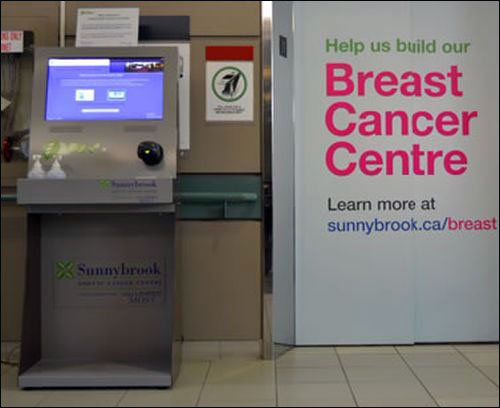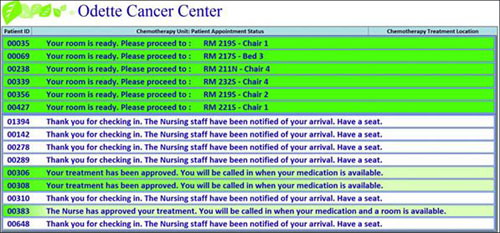The Odette Cancer Centre, part of the Sunnybrook Health Sciences Centre, in Toronto, Canada, has begun employing passive high-frequency (HF) radio frequency identification tags and readers to inform visiting patients of how long they must wait prior to receiving chemotherapy treatment or other services, and to reduce the length of that wait. All patients carry an RFID-enabled ID card that helps them identify themselves as soon as they arrive, and allows the center to track their movements throughout the facility and be notified when they leave. In this way, the center intends to make visits shorter and more efficient for patients, since the health-care, pharmacy and laboratory staff members all know who is waiting at a particular location, and which services will be required next.
The Odette Cancer Centre claims to be the sixth largest cancer institution in North America, with more than 24,000 chemotherapy patient visits annually. For the past five years, Odette has used Bykart Software‘s Chemotherapy Appointment Reservation Manager (CHARM) software to manage appointments, as well as data that is shared between the chemotherapy unit, pharmacy and clinicians. It also displays patient updates for both patients and staff on an airport-style notification video screen. That software, according to Thane Fitzgerald, Bykart Software’s director of development, has enabled the center to increase its patient throughput by 47 percent, while shortening the wait time for patients receiving services.

In December 2011, the center began piloting a Bykart-designed kiosk with a Feig Electronics CPR40.30 RFID reader supplied RFID Canada. Its goal was to obtain location data and forward it to the CHARM system, thereby enabling the automated collection of location data that would help the system understand where each patient is, and thus expedite the next step. After determining that the RFID-based information could enhance the data being managed in the CHARM system, the center began providing the ID cards to new patients in summer 2012, with the solution being taken fully live as of February 2013.
Odette Cancer Centre’s continued goal is to make what could be a stressful visit as quick, efficient and comfortable for patients as possible. Most visit the center regularly while undergoing chemotherapy to fight breast cancer. Chemotherapy usually requires a series of visits involving the administration of neoplastic drugs intended to destroy cancer cells.
Each patient is issued an ID card with a built-in 13.56 MHz passive RFID tag compliant with the Near Field Communication (NFC) standards, says Bob Moroz, the president of RFID Canada, which supplied the RFID-enabled cards. The unique ID encoded to the card’s RFID tag is then stored in the CHARM software, along with the patient’s records. Upon arriving at the waiting room, a patient checks in at a kiosk by tapping her card against that kiosk’s built-in RFID reader, which captures the tag’s ID number. A screen on the kiosk then displays a welcome message to that patient by name, while the software determines her estimated wait time, based on the other patients at the office, and displays that information.
From that point on, the patient, until being called into an examination or treatment room, can view her status on a 42-inch digital notification board in the waiting room, which lists each patient’s ID number (rather than name) and her position in the queue, as well as when she can expect to be called in to see a physician. Rather than have an Odette nurse shout out each patient’s name to summon her to a particular room, that person’s ID is simply displayed, indicating that the patient can now be seen. In this way, explains Philomena Sousa, Sunnybrook’s oncology systems manager and process specialist, “patients are notified to go into the treatment unit via the electronic patient appointment monitor, allowing nurses to stay in the treatment unit with the patients.”
Click here to view a larger version of the above image.
The patient then proceeds to the treatment unit, where a second notification board displays the patient’s ID number, the room number to which she is being directed, and directions to that room. Upon arriving at her appointed room, she taps her card against an RFID reader to indicate that she has arrived. Meanwhile, the pharmacy receives an alert that the patient is ready, and can thus prepare or locate the required medication mix, and then send a runner to deliver that prescription to the appropriate room to which the patient has also been directed.
If an arriving patient is scheduled for an exam, the waiting room’s notification screen directs her to the examination room, where she then taps her tag against a standalone Feig Max50 reader, updating the CHARM system to indicate that she is now awaiting a physician. In the event that the patient is assigned for blood work, she would be directed to the blood lab, where an RFID interrogator is also positioned. She would then tap her ID badge against the reader, signifying her arrival.
Once the visit is complete, the patient is directed to a clinic area to make her next appointment. Here, too, there is an RFID reader kiosk installed, to interrogate the tag on her ID card. In that way, staff members know she is in the room, and can quickly call her to the desk for scheduling.
To date, the center has issued ID cards to approximately 5,000 patients, and has installed a total of four readers, three standalone and one built into the kiosk. The center’s management believes that the use of RFID technology will enable it to better identify bottlenecks, by knowing how long patients wait within any specific area prior to receiving service. The facility can also use the data to determine the times and days on which bottlenecks are a greater problem, and thereby respond by staffing or scheduling changes in order to improve that wait time.
Not only has the RFID system enabled the notification of patients regarding wait times and when they can proceed to their treatment room, Sousa says, but it has also provided the center with data to help it view its operations and bottlenecks, and to make decisions to reduce patient wait times. Employees are also utilizing that information to make each patient visit more efficient, by knowing when she is ready for the next step of her visit.
Most importantly, Sousa adds, the data enables patients to know their status at any given moment, thanks to the notification boards and monitors around the facility. “Patients can see and check their appointment status at any time,” she states. “They can leave for much-needed breaks and be reassured that they are still in the queue for treatment. This was a concern expressed by patients that this patient-arrival system has addressed.”
To further address this concern, Sousa says, the center intends to install a total of seven notification screens within a variety of waiting areas, as well as five in clinical areas.



